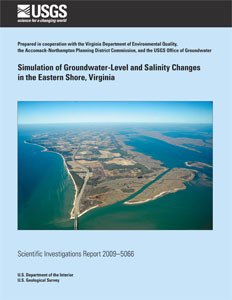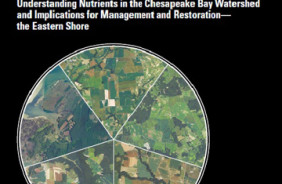
Product Details
- Product Number
- 213558
- Series
- SIR-2009-5066
- Scale
- NO SCALE
- Alternate ID
- SIR2009-5066
- ISBN
- 978-1-4113-2416-9
- Authors
- DAVID NELMS L
- Version Date
- 01/01/2009
- Regions
- VA
- Countries
- USA
- Media
- Paper
- Format
- Bound
Additional Details
- Description
- 7/31/2009 Abstract Groundwater-level and salinity changes have been simulated with a groundwater model developed and calibrated for the Eastern Shore of Virginia. The Eastern Shore is the southern part of the Delmarva Peninsula that is occupied by Accomack and Northampton Counties in Virginia. Groundwater is the sole source of freshwater to the Eastern Shore, and demands for water have been increasing from domestic, industrial, agricultural, and public-supply sectors of the economy. Thus, it is important that the groundwater supply be protected from overextraction and seawater intrusion. The best way for water managers to use all of the information available is usually to compile this information into a numerical model that can simulate the response of the system to current and future stresses. A detailed description of the geology, hydrogeology, and historical groundwater extractions was compiled and entered into the numerical model. The hydrogeologic framework is composed of a surficial aquifer under unconfined conditions, a set of three aquifers and associated overlying confining units under confined conditions (the upper, middle, and lower Yorktown- Eastover Formation), and an underlying confining unit (the St. Marys Formation). An estimate of the location and depths of two major paleochannels was also included in the framework of the model. Total withdrawals from industrial, commercial, public-supply, and some agricultural wells were compiled from the period 1900 through 2003. Reported pumpage from these sources increased dramatically during the 1960s and 70s, up to currently about 4 million gallons per day. Domestic withdrawals were estimated on the basis of population census districts and were assigned spatially to the model on the assumption that domestic users are located close to roads. A numerical model was created using the U.S. Geological Survey (USGS) code SEAWAT to simulate both water levels and concentrations of chloride (representing salinity). The model was calibrated using 605 predevelopment and transient water-level observations that are associated predominantly with 20 observation nests of wells sited across the study area. Sampling for groundwater chemistry at these sites revealed that chloride has not increased significantly in the last 20 years. Environmental tracers in the samples also indicated that the water in the surficial aquifer is typically years to decades old, whereas water in the confined aquifers is typically centuries to millennia old. The calibration procedure yielded distributions of hydraulic conductivity and storage coefficients of the aquifers and confining units that are based on 21 pilot points, but vary smoothly across the study area. The estimated values are consistent with other measurements of these properties measured previously on cores and during hydraulic tests at various well fields. Simulations performed with the model demonstrated that the calibrated model can reproduce the observed historical water levels fairly well (R2 = 0.93). The chloride concentrations were also simulated, but a match with chloride concentrations was more difficult to achieve (R2 = 0.16) because of the lack of sufficient data and the unknown exact behavior of the entire transition zone in the millennia leading up to the present day. Future pumping scenarios were simulated through 2050, with pumping set to either 2003 rates or total permitted withdrawal rates. Water levels in 2050 are predicted to be lower than current levels by a few feet where stresses are currently heaviest but potentially by tens of feet if total permitted withdrawals are extracted at current low-stressed sites. Simulations of chloride concentrations through 2050 revealed some potential for seawater intrusion in the areas of Cape Charles, Chincoteague, east of the town of Exmore, and east of the town of Accomac, but precise estimates of concentration increases are highly uncertain. Simulation results were also used to estimate that the downward transit time of potential dissolved contaminants (such as nitrate) across the uppermost confining unit is on the order of 100-300 years. An automated parameter estimation software package (UCODE) was used to help calibrate the model. This allowed for an analysis of errors, parameter sensitivities, and 95 percent confidence intervals. Overall, errors between observed and simulated water levels were typically small, and a comparison of weighted simulated observations and weighted residuals suggested no bias in the model. Calculations of the composite sensitivities of parameters indicated which parameters were well-constrained and which were not. The more well-constrained parameters typically lie in regions where long-term stresses have produced long-term drawdowns, such as in central Accomack County. The confining unit parameters generally were better constrained than the aquifer parameters. The confidence-interval results were consistent with the sensitivity results, indicating which parameters were more or less well-constrained. These results should help guide future work by indicating where additional data may yield the biggest improvements for a future model calibration.
- Survey Date
- 2009
- Print Date
- 2009
- Height In Inches
- 11.000
- Width In Inches
- 0.200
- Length In Inches
- 8.500
- Two Sided
- Yes
- Pieces
- 1
- Languages
- English
Related Items





